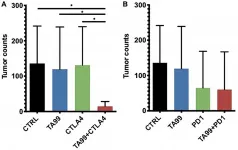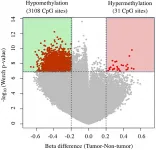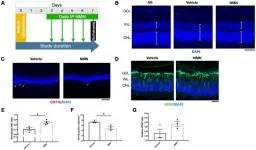(Press-News.org) The cover for issue 2 of Oncotarget features Figure 4, "Combination therapy TA99/ICB reduced the lung tumor burden in the B16 model of metastases," published in "Improved therapeutic efficacy of unmodified anti-tumor antibodies by immune checkpoint blockade and kinase targeted therapy in mouse models of melanoma" by Pérez-Lorenzo, et al. which reported that here, the authors showed that removing immune suppression and enhancing stimulatory signals increased the anti-tumor activity of unmodified TA99 antibodies with a significant reduction of growth of solid tumors and lung metastases in mouse models of melanoma.
Immune checkpoint blockade enhanced the efficacy of TA99, which was associated with greater CD8 /Foxp3 , NK1.1 and dendritic cell infiltrates, suggestive of an increased anti-tumor innate and adaptive immune responses.
Moreover, they found an improved therapeutic effect when YUMM tumor-bearing mice were treated with TA99 combined with MEKi and immune checkpoint blockade.
The Oncotarget findings suggest that MEKi induced an increased expression of tumor-associated antigens, which in combination with anti-tumor antibodies, generated a robust adaptive anti-tumor response that was sustained by immune checkpoint inhibition therapy.
The Oncotarget findings suggest that MEKi induced an increased expression of tumor-associated antigens, which in combination with anti-tumor antibodies, generated a robust adaptive anti-tumor response that was sustained by immune checkpoint inhibition therapy.
The authors postulate that combining anti-tumor antibodies with standard-of-care strategies such as immune checkpoint blockade or targeted therapy, will improve therapeutic outcomes in cancer.
Dr. Angela M. Christiano from The Columbia University said, "It is well accepted that tumor development and progression is usually controlled by immunosurveillance mechanisms in which specific and non-specific immunological responses are constantly mounted against tumor cells."
Passive administration of anti-tumor antibodies generally functions by targeting malignant cells through IgG-mediated antibody-dependent cellular cytotoxicity, which is a rapid but relatively short-acting anti-tumor response.
Alternatively, they and others also demonstrated that the administration of anti-tumor antibodies induces long-lasting FcR-dependent tumor specific immunity in the host, with kinetics consistent with an induced adaptive immune response against the tumor.
In this model, anti-tumor antibodies, alone or in combination with chemotherapy, will promote innate cell-mediated ADCC, and the capture and processing of antigens by antigen presenting cells, with the subsequent stimulation and homing of antigen-specific effector T lymphocytes to the tumor site, leading to tumor elimination, a phenomenon the researchers and others referred to as the “vaccinal effect”.
With the use of the B16 and YUMM mouse models of melanoma and the anti-TYRP1 mouse monoclonal antibody TA99, we demonstrated that the therapeutic effects of these unmodified anti-tumor antibodies can be enhanced by ICB through the stimulation of both innate and adaptive anti-tumor immune responses.
In addition, they found that the MEK inhibitor -induced increased expression of melanosomal antigens further enhanced the anti-melanoma response to combination therapy with anti-tumor antibodies and immune checkpoint blockade in mouse models of melanoma.
The Christiano Research Team concluded in their Oncotarget Research Paper, "Together with our preclinical data, these results invite further clinical investigation of unmodified anti-tumor antibodies in combination with ICB and targeted therapies, and may represent promising and innovative therapeutic interventions for the successful management of patients with advanced melanoma and other cancers."
Sign up for free Altmetric alerts about this article
DOI - https://doi.org/10.18632/oncotarget.27868
Full text - https://www.oncotarget.com/article/27868/text/
Correspondence to - Angela M. Christiano - amc65@cumc.columbia.edu
Keywords -
anti-tumor antibodies,
targeted therapy,
immunotherapy,
combination therapies,
melanoma
About Oncotarget
Oncotarget is a biweekly, peer-reviewed, open access biomedical journal covering research on all aspects of oncology.
To learn more about Oncotarget, please visit https://www.oncotarget.com or connect with:
SoundCloud - https://soundcloud.com/oncotarget
Facebook - https://www.facebook.com/Oncotarget/
Twitter - https://twitter.com/oncotarget
LinkedIn - https://www.linkedin.com/company/oncotarget
Pinterest - https://www.pinterest.com/oncotarget/
Reddit - https://www.reddit.com/user/Oncotarget/
Oncotarget is published by Impact Journals, LLC please visit http://www.ImpactJournals.com or connect with @ImpactJrnls
The cover for issue 1 of Oncotarget features Figure 2, "Results in clinical trials," published in "Drug resistant cells with very large proliferative potential grow exponentially in metastatic prostate cancer" by Blagoev, et al. which reported that most metastatic cancers develop drug resistance during treatment and continue to grow, driven by a subpopulation of cancer cells unresponsive to the therapy being administered.
There is evidence that metastases are formed by phenotypically plastic cancer cells with stem-cell-like properties.
Currently, the population structure and growth dynamics ...
The cover for issue 52 of Oncotarget features Figure 1, "Volcano plots of DNA methylation in tumor tissues compared with nontumor tissue," published in "Reduction of T-Box 15 gene expression in tumor tissue is a prognostic biomarker for patients with hepatocellular carcinoma" by Morine, et al. which reported that the authors conducted a genome-wide analysis of DNA methylation of the tumor and non-tumor tissue of 15 patients with Hepatocellular carcinoma (HCC), and revealed TBX15 was the most hypermethylated gene of the tumor.
Another validation set, which comprised 58 HCC with radical resection, was analyzed to investigate the relationships between tumor phenotype and TBX15 mRNA expression.
TBX15 mRNA levels in tumor tissues were significantly lower compared ...
Aging-US Issue 1 Volume 13 features "PAM (PIK3/AKT/mTOR) signaling in glia: potential contributions to brain tumors in aging" which reported that despite a growing proportion of aged individuals at risk for developing cancer in the brain, the prognosis for these conditions remains abnormally poor due to limited knowledge of underlying mechanisms and minimal treatment options.
While cancer metabolism in other organs is commonly associated with upregulated glycolysis and hyperactivation of PIK3/AKT/mTOR pathways, the unique bioenergetic demands of the central nervous system ...
Aging-US published "Neuroprotective effects and mechanisms of action of nicotinamide mononucleotide (NMN) in a photoreceptor degenerative model of retinal detachment" which reported that here, the authors investigated nicotinamide mononucleotide, a precursor of nicotinamide adenine dinucleotide, in a retinal detachment induced photoreceptor degeneration.
NMN administration after RD resulted in a significant reduction of TUNEL photoreceptors, CD11b macrophages, and GFAP labeled glial activation; a normalization of protein carbonyl content, and a preservation of the outer nuclear layer thickness.
NMN administration significantly increased NAD levels, SIRT1 protein expression, and heme oxygenase-1 expression.
Delayed NMN administration still exerted protective effects after RD.
This ...
A nuclear war could trigger an unprecedented El Niño-like warming episode in the equatorial Pacific Ocean, slashing algal populations by 40 percent and likely lowering the fish catch, according to a Rutgers-led study.
The research, published in the journal END ...
DALLAS, Jan. 25, 2021 -- Psychological health can positively or negatively impact a person's health and risk factors for heart disease and stroke, according to "Psychological Health, Well-Being, and the Mind-Heart-Body Connection," a new American Heart Association Scientific Statement, published today in the Association's flagship journal Circulation. The statement evaluates the relationship between psychological health and heart health, summarizing ways to help improve psychological health for people with and at risk for heart disease.
"A person's mind, heart and body are all interconnected and interdependent in what can be termed 'the mind-heart-body-connection,'" said Glenn N. Levine, M.D., FAHA, master clinician and professor of medicine at ...
DALLAS, Jan. 25, 2021 -- The continued global burden of stroke and how it disproportionately affects women are highlighted in new science published online today in the February issue of Stroke, a journal of the American Stroke Association, a division of the American Heart Association. Stroke editors selected nine manuscripts focused on stroke disparities in women in this collaboration with Go Red for Women®, the Association's global movement to end heart disease and stroke in women.
"Stroke continues to be a leading cause of death and disability worldwide, with women being more adversely affected by the global burden of stroke," said Stroke Editor-In-Chief Ralph L. Sacco, M.D., M.S., FAHA, ...
Scientists have identified a key nutrient source used by algae living on melting ice surfaces linked to rising sea levels.
The Greenland ice sheet - the second largest ice body in the world after the Antarctic ice sheet - covers almost 80% of the surface of Greenland. Over the last 25 years, surface melting and water runoff from the ice sheet has increased by about 40%.
The international research team, led by the University of Leeds, analysed samples from the southwestern margin on Greenland's 1.7 million km² ice sheet over two years.
They discovered that phosphorus containing minerals may be driving ever-larger algal blooms on the Greenland Ice Sheet. As the algal blooms grow they darken the ice surface, decreasing albedo - ...
EAST LANSING, Mich. - An international team of researchers led by Michigan State University's Morteza Mahmoudi has developed a new method to better understand how nanomedicines -- emerging diagnostics and therapies that are very small yet very intricate -- interact with patients' biomolecules.
Medicines based on nanoscopic particles have the promise to be more effective than current therapies while reducing side effects. But subtle complexities have confined most of these particles to research labs and out of clinical use, said Mahmoudi, an assistant professor in the Department of Radiology and the Precision Health Program.
"There's been a considerable investment of taxpayer money in cancer nanomedicine research, but that research hasn't successfully translated ...
Even before public announcements of the first cases of COVID-19 in Europe were made, at the end of January 2020, signals that something strange was happening were already circulating on social media. A new study of researchers at IMT School for Advanced Studies Lucca, published in END ...






